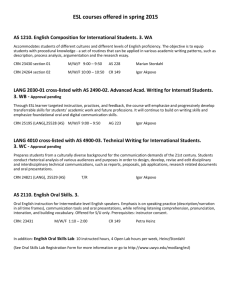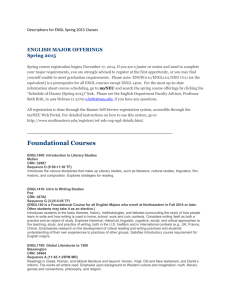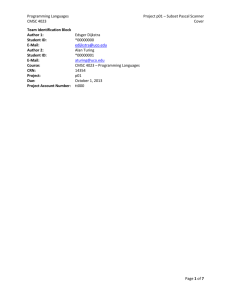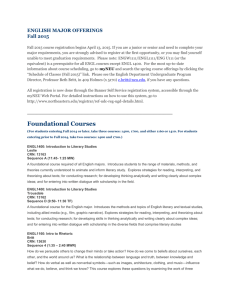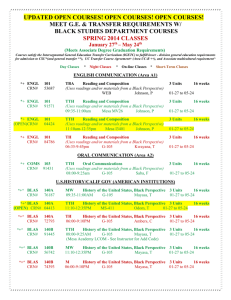Test 3 t3r1s12
advertisement
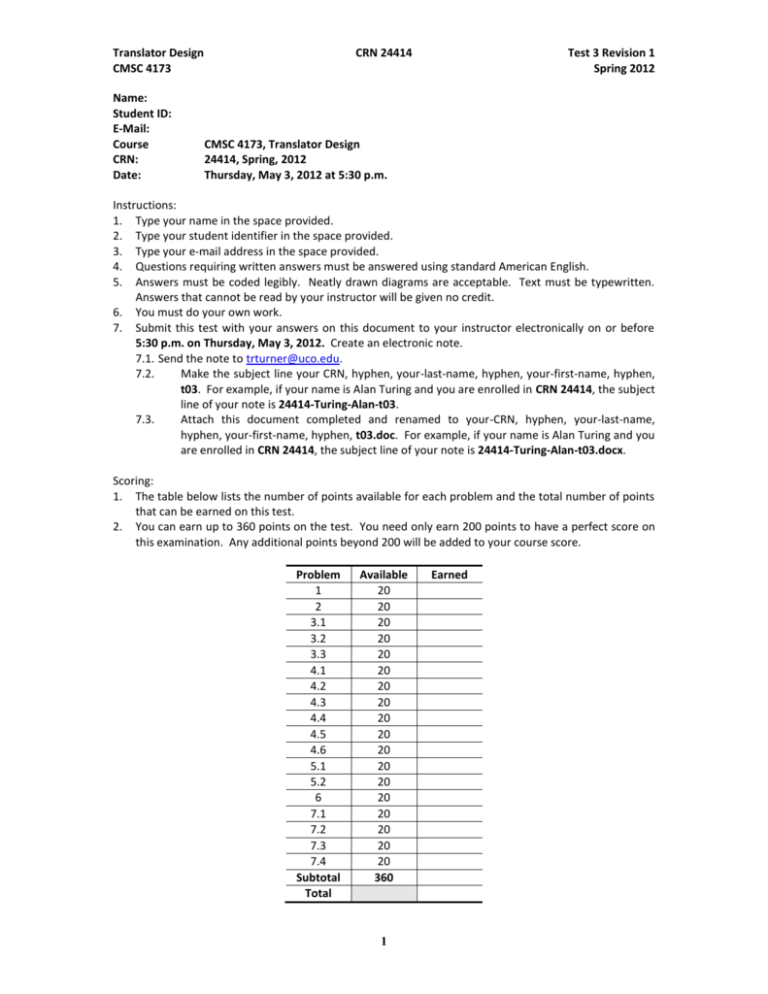
Translator Design
CMSC 4173
Name:
Student ID:
E-Mail:
Course
CRN:
Date:
CRN 24414
Test 3 Revision 1
Spring 2012
CMSC 4173, Translator Design
24414, Spring, 2012
Thursday, May 3, 2012 at 5:30 p.m.
Instructions:
1. Type your name in the space provided.
2. Type your student identifier in the space provided.
3. Type your e-mail address in the space provided.
4. Questions requiring written answers must be answered using standard American English.
5. Answers must be coded legibly. Neatly drawn diagrams are acceptable. Text must be typewritten.
Answers that cannot be read by your instructor will be given no credit.
6. You must do your own work.
7. Submit this test with your answers on this document to your instructor electronically on or before
5:30 p.m. on Thursday, May 3, 2012. Create an electronic note.
7.1. Send the note to trturner@uco.edu.
7.2.
Make the subject line your CRN, hyphen, your-last-name, hyphen, your-first-name, hyphen,
t03. For example, if your name is Alan Turing and you are enrolled in CRN 24414, the subject
line of your note is 24414-Turing-Alan-t03.
7.3.
Attach this document completed and renamed to your-CRN, hyphen, your-last-name,
hyphen, your-first-name, hyphen, t03.doc. For example, if your name is Alan Turing and you
are enrolled in CRN 24414, the subject line of your note is 24414-Turing-Alan-t03.docx.
Scoring:
1. The table below lists the number of points available for each problem and the total number of points
that can be earned on this test.
2. You can earn up to 360 points on the test. You need only earn 200 points to have a perfect score on
this examination. Any additional points beyond 200 will be added to your course score.
Problem
1
2
3.1
3.2
3.3
4.1
4.2
4.3
4.4
4.5
4.6
5.1
5.2
6
7.1
7.2
7.3
7.4
Subtotal
Total
Available
20
20
20
20
20
20
20
20
20
20
20
20
20
20
20
20
20
20
360
1
Earned
Translator Design
CMSC 4173
CRN 24414
Test 3 Revision 1
Spring 2012
1.
2.
(20 points) Diagram and briefly describe the phases of a compiler.
(20 points) Construct a nondeterministic finite automata for the regular expression
(a | b) * abb(a | b) * .
3.
Construct minimum-state DFA’s for the regular expression (a | b) * a (a | b) .
4.
3.1. (20 points) Construct a NFA for the regular expression (a | b) * a (a | b) .
3.2. (20 points) Convert the NFA found in 3.1. to a DFA.
3.3. (20 points) Minimize the DFA found in 3.2.
Create an SLR grammar for logical expressions.
4.1. (20 points) Construct a grammar for logical expressions. Logical expressions have operators
and, or, and not as shown in the Table 4. Parenthesized expressions are permitted. Operands
consist of 0 or 1, where 0 signifies false and 1 signifies true. Operators are ranked by
precedence where the operator having highest precedence is the grouping operator, ( ).
Operator
()
~
*
+
5.
Meaning
grouping
operator
not
and
or
Operands
NA
Precedence
1
Associativity
left-to-right
unary
2
right-to-left
binary
3
left-to-right
binary
4
left-to-right
Table 4. Logic operators
4.2. (20 points) Construct the first set for all the non-terminals in your grammar.
4.3. (20 points) Construct the follow set for all the non-terminals in your grammar.
4.4. (20 points) Construct the canonical LR(0) collection for your augmented grammar.
4.5. (20 points) Construct the action-goto SLR parsing table for your augmented grammar
4.6. (20 points) Construct a table that records the moves of an LR parser similar to the table shown
in Figure 4.38 on page 253 of Compilers: principles, techniques, and tools 2 nd Ed by Aho, Sethi,
and Ullman or Figure 4.32 on page 220 of Compilers, principles, techniques, and tools by Aho,
Sethi, and Ullman for the expression a b * c, where a , b, and c are logic variables.
Consider the grammar in Table 5. Parse trees are discussed in section 4.2.4 of your text, Compilers:
principles, techniques, and tools / Aho, A. V. et al. 2 nd ed. Terminal symbols are printed in bold.
Terminal symbols include +, -, *, /, (, ), id, intlit, and realit. An identifier, id, begins with a letter and
can have zero or more subsequent letters or digits. An integer literal, intlit, consists of one or more
digits. A real literal, realit, is an integer literal and an exponent or a decimal value followed by an
optional exponent. A real literal has no embedded blank characters. A decimal value is a decimal
point with at least one digit on either side of the decimal point. An exponent is the letter e or E,
followed by an optional sign, followed by an integer literal.
1
2
3
4
5
6
7
8
9
10
expression
term
expression
expression+term
expression
expression-term
term
factor
term
term*factor
term
term/factor
factor
(expression)
factor
id
factor
intlit
factor
realit
Table 5. Expression grammar
2
Translator Design
CMSC 4173
CRN 24414
5.1. (20 points) Construct a parse tree of the expression (f-32)*5/9.
5.2. (20 points) Construct an expression tree for expression (f-32)*5/9.
3
Test 3 Revision 1
Spring 2012
Translator Design
CMSC 4173
6.
CRN 24414
Test 3 Revision 1
Spring 2012
(20 points) Draw diagrams that represent symbol table entries for the declaration given in Figure 6.
var a:array[-5..4] of char;
Figure 6. Declaration for question 6.
7.
Translate program p01 in figure 7 to P-Code. Put your answer in Table 7.
program p01;
var a: integer;
function celcius(f:real):real;
begin
celcius:=(f-32)*5/9
end{celcius};
begin{p01}
WriteInteger(celcius(77))
end{p01}.
Figure 7. Program for question 7.
7.1. (20 points) Complete the Label Table in Figure 7.1.
Label
Value
Table 7.1 Label Table
7.2. (20 points) Complete the Constant Tables in Figures 7.2. and 7.3.
Index
Integer constant
Table 7.2 Integer constants
Index
Real constant
Table 7.3 Real constants
4
Translator Design
CMSC 4173
CRN 24414
Test 3 Revision 1
Spring 2012
7.3. (20 points) Complete the PCode Instruction Table in Figure 7.4..
Index
Label
opcode
operand
1
Table 7.4 P-Code Instructions
5
operand
2
